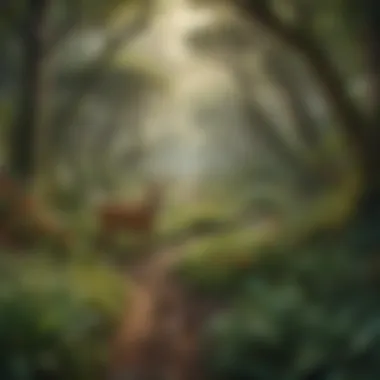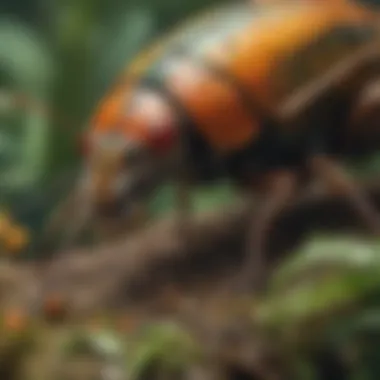A Critical Look at George Monbiot's 'Feral'


Intro
George Monbiot's book Feral invites readers to rethink the relationship between humans and the natural world. At its core lies a challenge to traditional conservation methods, pushing for a deeper, more integrated approach. Monbiot’s argument centers on the idea of rewilding—allowing nature to reclaim its territories and fostering biodiversity in ways that were largely neglected by conventional practices. This perspective not only appeals to environmentalists but carries implications for a wider audience, compelling us to consider how we manage land and nature in a rapidly changing world.
This analysis will explore Monbiot’s central themes and their relevance in contemporary discussions about ecology and land management. By dissecting key insights from Feral, we’ll uncover the intricacies of rewilding and ecological restoration, as well as delve into the socio-political ramifications embedded in these concepts.
Key Concepts and Insights
Main Ideas from the Book
Monbiot articulates a compelling vision for the future of conservation. Central to this vision is the notion that in order for nature to thrive, humanity must step back and allow it to flourish without interference. A few of the main concepts discussed in Feral include:
- Rewilding: This involves restoring ecosystems to their natural state. Monbiot suggests reintroducing missing species—including wolves and beavers—to rebuild ecological balance.
- Ecological Restoration: Rather than simply protecting existing areas, Monbiot pushes for an active restoration of damaged landscapes.
- Socio-Political Implications: The discussion is not merely scientific; it intersects with land ownership, agricultural practices, and political will, questioning what it really means to coexist with nature.
"To truly restore nature, we must revisit our frameworks and reimagine our responsibilities."
Practical Applications of Concepts
Monbiot's ideas are not just theoretical; they pave pathways for practical applications. For instance:
- Community Engagement: Local communities can participate in rewilding projects, leading to a nuanced understanding of biodiversity.
- Policy Making: Policymakers can base new legislation on the principles of ecological restoration, prioritizing biodiversity over industrial projects.
- Sustainable Practices: Land managers can adopt practices that emulate natural processes, promoting healthier ecosystems while providing for human needs.
Recommendations and Further Reading
Related Books to Explore
- The Hidden Life of Trees by Peter Wohlleben: A compelling exploration of how trees communicate and support each other.
- Braiding Sweetgrass by Robin Wall Kimmerer: This book emphasizes the connection between people and nature, rooted in Indigenous wisdom.
- Wilding by Isabella Tree: A practical account of rewilding efforts in the UK, showcasing real-world examples.
Additional Resources for Personal Development
- Visit Wikipedia for background on ecological concepts and rewilding.
- Explore discussions on rewilding trends on Reddit.
- Join conversations on conservation strategies at Facebook.
By thoroughly engaging with Monbiot's Feral, readers can begin to unravel the intricate threads that bind us to the natural environment. It calls for a revolutionary approach to conservation, encouraging an evolved perspective that transcends traditional boundaries.
Preamble to 'Feral'
The landscape of conservation is often painted with broad strokes that fail to capture the intricacies of our relationship with nature. In this regard, George Monbiot’s book Feral serves as a pivotal discourse. It challenges traditional frameworks of environmental stewardship, offering fresh views that merit serious consideration. Understanding Feral is not merely an academic pursuit but also a social imperative as we navigate the ecological crises of our time.
Monbiot’s work becomes a lens through which we can examine pressing issues like biodiversity loss, habitat destruction, and the psychological disconnection many people feel towards the natural world. By bringing attention to Feral, we embark on a journey that highlights urgent themes relevant to contemporary environmental discourse. This article aims to dissect these themes, weaving a narrative that enriches the reader's understanding of Monbiot's thought processes and the implications they hold for our future.
Understanding George Monbiot's Perspective
George Monbiot, with his distinctive voice, engages readers in a vivid conversation about rewilding, the restoration of ecosystems, and the consequences of human encroachment. His perspective is multifaceted, rooted deeply in personal experiences and extensive environmental research. Monbiot argues for a reimagined world where human beings do not merely exist in nature, but interact with it symbiotically. He advocates for a radical shift from exploitative practices to a more hands-off approach, one that allows nature to reclaim its space.
His work invites us to reckon with historical injustices that have led to the current state of ecosystems today. Through this lens, Monbiot articulates a vision of a world where wildness is not seen as a threat to civilization, but rather as an integral component of a balanced ecological system. His perspective resonates with environmentalists, policymakers, and all of us who tread upon this earth, as it serves as a reminder of our responsibilities.
Contextual Background of the Book
To appreciate the significance of Feral, it’s essential to ground the book within its broader context. Published in 2013, Feral emerged during a time marked by increasing environmental awareness and activism, yet also amidst powerful counter-narratives defending conventional conservation methods. Monbiot’s critique of these methods shines a light on their limitations; he emphasizes that simply preserving existing landscapes might not suffice in an age of rapid climatic and ecological change.
The backdrop of Feral is also shaped by a growing recognition of the need for biodiversity. The decline of species and habitats has become a pressing concern, urging many to reconsider how we define conservation. Monbiot’s call for rewilding as a potentially transformative approach comes against the grain of traditional views that often see human intervention as necessary. Instead, he turns the narrative on its head, advocating for a pivot towards allowing natural processes to unfold. This perspective invites extensive discussions on land management, wildlife preservation, and restoration techniques, thus setting the stage for the critical themes that will be explored throughout this article.


"We’re a part of nature, not apart from it."
In essence, the importance of the introductory section of Feral cannot be overstated. It lays a foundation for an invaluable dialogue on the complex relationships binding humans and the wild. This exploration goes far beyond mere environmental advocacy, delving into the social and political ramifications intertwined with our choices and actions today.
Core Themes of the Book
In 'Feral', George Monbiot delves into several core themes that challenge traditional views on nature and conservation. Understanding these themes is crucial for grasping Monbiot's vision of a more integrated relationship between humanity and the wild. At their heart, these concepts urge us to rethink our role in shaping ecosystems, highlighting not just the environmental benefits but also the ethical and philosophical considerations involved in conservation efforts. Each theme interrelates, pointing to the need for a holistic approach to biodiversity and cohabitation with the natural world.
The Concept of Rewilding
Rewilding, at its essence, advocates for allowing nature to reclaim areas that have been systematically altered by human interference. Monbiot captivates readers with the idea that landscapes are not merely backdrops for human activity but dynamic systems that thrive when given the opportunity to restore themselves. This concept goes beyond simply letting nature take its course; it involves active strategies such as reintroducing keystone species and reducing human presence in certain regions.
Rewilding challenges societal norms about land use, suggesting that we must let go of our control over nature. The reintroduction of wolves to Yellowstone National Park serves as a classic example. This pivotal moment not only affected local fauna but also transformed the ecosystem's flora and hydrology. Such examples provoke deep consideration, prompting us to ask: are we brave enough to step back and allow the wild to flourish?
Biodiversity and Its Importance
In a world increasingly marked by urban sprawl and development, Monbiot emphasizes the critical importance of biodiversity. Biodiversity, the variety of life in a particular habitat, is not just a luxury; it is fundamental to the health and resilience of ecosystems. When species are lost, ecosystems falter, which can produce dire consequences for humanity itself.
• Biodiversity supports ecosystem services such as food production, climate regulation, and clean water.
• It also fosters resilience against diseases and climate change, making ecosystems robust and adaptable.
By focusing on biodiversity, Monbiot highlights our interdependence with the natural world. Ignoring this interconnectedness is risking not just wildlife but ourselves. As Monbiot succinctly puts it, "Nature is not a commodity. It is a foundation for our existence."
Human Impact on Ecosystems
Monbiot does not shy away from discussing the often negative impacts of human activity on natural ecosystems. From deforestation to pollution, the footprint of humanity has led to severe disruptions in biological diversity. He brings to light the consequences of these actions, showcasing real-world examples of how ecosystems collapse in the face of relentless exploitation.
There’s a stark reality here. The degradation of peat bogs, for instance, releases stored carbon into the atmosphere, exacerbating climate change. The ever-growing urban landscape fragments habitats, posing a continuous threat to myriad species.
"We did not kill the rivers and the forests, but we sure do not help them recover from our presence," Monbiot warns.
This theme calls for a reevaluation of our actions and their repercussions on our planet. It begs the question: Can we forge a new path that acknowledges our impact while providing spaces for the healing of ecosystems?
Through these themes, Monbiot’s 'Feral' becomes a profound exploration of what it means to coexist with nature, ultimately advocating for a future where humanity is not the enemy of the wild but a partner in its flourishing.
Ecological Restoration in Focus
Ecological restoration is a crucial theme in George Monbiot's book 'Feral.' It serves as a focal point, emphasizing the need to mend the damage humans have inflicted on the environment. This topic is not just a trend in conservation; it's a vital necessity compelled by the alarming state of our ecosystems. Through Monbiot's lens, we understand that restoration goes beyond merely planting trees or reintroducing species; it's about fostering resilient ecosystems that can thrive independently.
The importance of focusing on ecological restoration lies in its multifaceted benefits. Not only does it aim to revive degraded ecosystems, but it also plays a fundamental role in combating climate change and enhancing biodiversity. Healthy ecosystems can sequester carbon, improve soil quality, and enhance water retention. In addition, they provide habitat for various species, both flora and fauna, creating a balance that is essential for our planet's health.
Through restoration projects, communities can reconnect with nature, fostering an awareness that has the potential to reshape human-nature relationships. However, embarking on such initiatives is not without its challenges. It requires a shift in how land is viewed and treated, demanding cooperation among stakeholders, including local communities, governments, and conservation organizations.
Monbiot argues that successful restoration necessitates an understanding of native species, ecological processes, and the socio-political context of land use. The question remains: how do we recast our approach to not only fit into these complexities but to also actively promote ecological resilience?
"Restoration is not just about putting things back the way they were; it's about creating pathways for ecosystems to adapt and thrive in an ever-changing environment."
Principles of Ecological Restoration
The principles of ecological restoration, as discussed by Monbiot, resonate with a core idea: understanding ecosystems means respecting them. One of the primary principles is that successful restoration should mimic natural processes. This means considering how ecosystems function naturally and seeking not to impose artificial structures and controls.


Also, restoration ought to focus on the local context. To put it plainly, what works in one location may not be suitable for another. Monbiot advocates for identifying native species and understanding their ecological roles as a foundation for the restoration process.
Restoration projects are often iterative and adaptive. This means that plans should evolve based on observations and outcomes. Engaging local communities in this learning process can yield insights that might escape the attention of scientists and policymakers.
Case Studies Highlighted by Monbiot
Monbiot presents several compelling case studies in 'Feral' that illustrate the concepts of ecological restoration. One notable example is the restoration of the Scottish Highlands. Here, initiatives to reintroduce native species like the European beaver have shown positive ripple effects—enhancing habitats, improving water quality, and promoting biodiversity.
Another highlight is the efforts in Wales, aimed at rewilding areas to allow natural processes to unfold. These projects have restored not just the landscapes but also the cultural appreciation of nature among local populations.
The outcomes observed in these regions raise pertinent questions:
- How can we apply such lessons to other ecosystems?
- What are the social implications and benefits of restoring natural environments?
Through these examples, Monbiot illustrates that ecological restoration is not merely a technical endeavor; it is a journey of reestablishing connections between people and nature, where every effort contributes to a broader vision of environmental stewardship.
The Socio-Political Dimensions
Understanding the socio-political dimensions in George Monbiot's Feral is crucial for grasping how environmental issues interlace with culture, policy, and human behavior. This section delves into the intricate relationships between land ownership and management practices, alongside cultural attitudes towards nature, shaping our interactions with the environment.
Land Ownership and Management
Land ownership isn’t just a legal matter; it’s tied to identity, power dynamics, and ecological practices. Monbiot explores how traditional land ownership often leads to practices that can hinder ecological restoration efforts. When a handful of individuals or corporations control vast areas of land, the potential for rewilding is stunted. The motivations of these landowners may lean toward profit rather than ecological stewardship.
Monbiot advocates for a more egalitarian approach to land management. The idea is to democratize land use, allowing local communities to participate in decision-making. Communities often possess indigenous knowledge and a strong vested interest in the health of their environment, making them valuable stewards of natural resources. By involving these groups, a more sustainable form of land management could emerge.
- Benefits of Community Involvement
- Enhanced biodiversity due to diverse land management practices.
- Increased public buy-in for conservation efforts.
The implications of such changes are profound. If more people can manage land, we can see a shift in priorities—moving towards ecological balance rather than purely economic gain. This doesn’t mean ditching all traditional practices; rather, it’s about integrating modern techniques with historical knowledge to create a more sustainable future.
Cultural Attitudes Towards Nature
Cultural attitudes towards nature play a pivotal role in shaping people’s relationship with the environment. Monbiot's critique offers a lens to evaluate how various sociocultural factors influence conservation efforts. In many parts of the world, there exists a disconnect between humans and nature—a notion stemming from the Industrial Revolution and reinforced by urbanization.
This detachment paves the way for exploitative behaviors, where nature is viewed merely as a resource to be consumed rather than a community to which we belong.
Monbiot posits that fostering a cultural renaissance—one where nature is cherished—would create significant breakthroughs in conservation strategies. Rather than seeing ourselves as separate from the natural world, there needs to be recognition that we are part of a larger ecosystem. This shift can be executed through education and media.
"When people feel connected to nature, they are more likely to invest in its preservation."
- Tactics to Shift Attitudes
- Education Programs: Teaching younger generations about ecological principles.
- Art and Media: Utilizing storytelling and visual arts to illustrate the importance of nature.
By altering cultural attitudes, restoration projects may gain the momentum they need. Communities equipped with both knowledge and a positive attitude toward nature can be crucial players in developing meaningful conservation interventions.
In essence, the socio-political dimensions outlined by Monbiot in Feral provide a comprehensive framework to understand how urgent ecological restorations hinge upon reshaping not just policies but also our collective mentality towards nature.
Critiques and Counterarguments


In the realm of environmental discussions, it's vital to engage with critiques and counterarguments surrounding concepts like rewilding. This section unpacks the various criticisms of George Monbiot's ideas as presented in his book 'Feral'. These critiques not only challenge Monbiot's viewpoint but also pave the way for a healthier debate about conservation strategies and their broader implications.
Critics of Rewilding
Rewilding, despite its lofty intentions, has gained its share of scrutiny. Some critics argue that it may lead to unforeseen consequences for local ecosystems. For instance, the reintroduction of key species can upset existing balances. An example can be drawn from the reintroduction of wolves in Yellowstone, where their return has catalyzed dramatic ecological changes, arguably beneficial yet disruptive to others in the habitat.
Furthermore, economic concerns surface consistently in these discussions. Landowners often feel that rewilding encroaches on their livelihood. They fear that introducing wildlife may hurt livestock or crop production. Basically, folks are caught between conservation ideals and everyday realities of their farms and lives.
Beyond ecological and economic implications, there's also a philosophical angle. Some argue that the term 'rewilding' itself can be misleading. Is it possible to genuinely restore wilderness, or are we just creating a new form of landscape management? Critics like Sue Heavenrich emphasize that the idealized versions of wilderness may gloss over the complexity and nuance of real-world ecosystems which have evolved with human presence.
Alternative Views on Conservation
When it comes to conservation, proponents of alternative views often call for a more integrated approach rather than choosing sides between preservation and rewilding. One notable perspective is that of community-driven conservation. This angle highlights local stewardship as essential in maintaining biodiversity. For example, indigenous practices often emphasize a balance between use and preservation, generating sustainable ecosystems that have thrived for generations.
Another viewpoint pushes for a pragmatic stance towards conservation. This perspective argues that rather than aiming to recreate a distant past, conservation efforts should adapt to the current circumstances of the environment. This includes accepting some level of human impact and focusing on adaptive management strategies.
Moreover, there are others who embrace technology and modernity as part of conservation efforts. Concepts like urban ecology and conservation tech introduce new ways for humans to coexist with nature, blending innovation with preservation seamlessly.
In summary, critiques of Monbiot's rewilding focus on complexities and practicality. While rewilding presents innovative ideas, embracing alternative paths may provide a holistic approach towards ecological restoration and conservation at large.
"Rewilding must not only restore nature but must also lift the voices of those who tend to the land." – Adapted from common insights on community conservation.
Implications for Future Conservation Efforts
The implications for future conservation efforts, as discussed in George Monbiot's 'Feral', hold significant weight in shaping our approach toward environmental protection. At its core, the book challenges traditional conservation methods and offers a fresh perspective that emphasizes restoring ecosystems and fostering biodiversity. This shift in focus underlines the necessity for more adaptive strategies and innovative policies that prioritize rewilding and ecological restoration. The future of conservation hinges on the willingness to embrace change and rethink how human activities intersect with nature.
Policy Changes Required
An essential component of Monbiot’s vision centers around the call for comprehensive policy reforms. To effectively address the pressing issues of habitat destruction, climate change, and biodiversity loss, policymakers must prioritize the implementation of adaptive policies that encourage rewilding initiatives. These changes necessitate:
- Legislative Support for Ecological Restoration: Crafting laws that facilitate the restoration of natural habitats can allow the flora and fauna to flourish once again. This could involve reallocating land use, creating protected areas, and ensuring access to resources for native species.
- Incentives for Landowners: It's imperative to offer incentives to landowners who choose to engage in rewilding practices. Financial support, insurance for rewilded land, and tax breaks could spur more individuals to embrace ecological restoration on their properties.
- Educational Initiatives: To change public perception, educational programs about the benefits of biodiversity and ecosystem restoration need to be integrated into school curriculums and community outreach. Awareness can drive a demand for policy change.
These types of changes not only benefit the environment but can also enhance community well-being and economic stability as ecosystems recover and biodiversity thrives.
Community Involvement
The heart of Monbiot's philosophy is rooted in the belief that conservation cannot be an isolated effort. Community involvement plays an acknowledged yet often underestimated role in the success of ecological initiatives. Emphasizing local participation can lead to:
- Collective Action: When communities come together, they can have a lasting impact on their local environment. Initiatives like community forests or wildlife corridors can be driven by the people who understand their land best.
- Empowerment and Ownership: Involving locals in the decision-making process fosters a sense of responsibility toward their habitats. When people feel ownership over their environment, they are more likely to take steps to protect and restore it.
- Integration of Traditional Knowledge: Local communities often possess valuable traditional knowledge about their ecosystems. Recognizing and integrating these insights can enhance conservation strategies and make them more effective in the long run.
Monbiot's exploration of these concepts illustrates that the future of conservation is not solely in the hands of policymakers or ecological experts but is fundamentally tied to community engagement. By marrying these strategies—formal policy reform and grassroots action—there's a better chance of creating a sustainable, harmonious relationship between humans and nature.
Closure
In concluding the exploration of George Monbiot's 'Feral', it is essential to grasp the broader implications of his assertions regarding our interaction with the natural environment. Monbiot urges a shift in how we perceive and engage with landscapes, challenging us to rethink not only our conservation strategies but also our fundamental connection to nature.
Summarizing Monbiot's Contributions
Monbiot's work is reflective of a critical voice in conservation discourse, intertwining ethical considerations with scientific insights. His advocacy for rewilding serves as a call to arms for both policymakers and the general public, urging a transformation in land management practices. By emphasizing the need for restored ecosystems, he brings attention to the stark reality that many environments suffer from neglect and exploitation.
His concept of rewilding moves beyond merely reintroducing species; it encapsulates a holistic approach to ecological restoration that considers historical context, biodiversity, and the socio-economic factors at play. Through detailed case studies, such as those involving the restoration of wolves in Yellowstone National Park, Monbiot illustrates the cascading effects that the reintroduction of apex predators can have on restoring ecological balance. Moreover, he champions the idea that healthy ecosystems can offer solutions to some of society's pressing challenges, such as climate change and food insecurity.
Reflections on Our Relationship with Nature
Monbiot’s insights compel us to reflect on our current relationship with the natural world. It's a relationship often marred by a sense of separation, where human interests overshadow the values of other species. This discourse nudges us toward a more integrated worldview, advocating for an acknowledgment that humans are part of a broader ecological community.
Whether it be through urban green spaces or national parks, the reminders of our shared existence with nature invite consideration of what it means to coexist. Societies thrived when they took cues from natural processes, learning from the resilience and adaptability observed in nature. By nurturing this relationship, we could pave the way for a sustainable future, steeped in an understanding of respect and stewardship.
Ultimately, Monbiot’s book acts not just as a critique but as a blueprint for reimagining our place in the ecosystem—emphasizing cohabitation, respect, and a genuine commitment to restoring balance. This final analysis emphasizes that engaging with the narratives Monbiot presents enriches our own understanding of conservation and offers pathways for future action.







